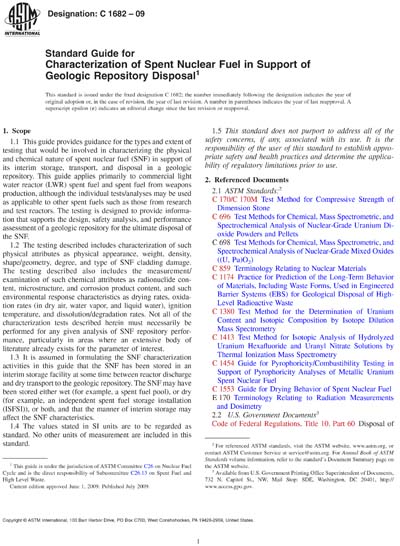Historical
ASTM C1682-09
Standard Guide for Characterization of Spent Nuclear Fuel in Support of Geologic Repository Disposal
1.1 This guide provides guidance for the types and extent of testing that would be involved in characterizing the physical and chemical nature of spent nuclear fuel (SNF) in support of its interim storage, transport, and disposal in a geologic repository. This guide applies primarily to commercial light water reactor (LWR) spent fuel and spent fuel from weapons production, although the individual tests/analyses may be used as applicable to other spent fuels such as those from research and test reactors. The testing is designed to provide information that supports the design, safety analysis, and performance assessment of a geologic repository for the ultimate disposal of the SNF.
1.2 The testing described includes characterization of such physical attributes as physical appearance, weight, density, shape/geometry, degree, and type of SNF cladding damage. The testing described also includes the measurement/examination of such chemical attributes as radionuclide content, microstructure, and corrosion product content, and such environmental response characteristics as drying rates, oxidation rates (in dry air, water vapor, and liquid water), ignition temperature, and dissolution/degradation rates. Not all of the characterization tests described herein must necessarily be performed for any given analysis of SNF repository performance, particularly in areas where an extensive body of literature already exists for the parameter of interest.
1.3 It is assumed in formulating the SNF characterization activities in this guide that the SNF has been stored in an interim storage facility at some time between reactor discharge and dry transport to the geologic repository. The SNF may have been stored either wet (for example, a spent fuel pool), or dry (for example, an independent spent fuel storage installation (ISFSI)), or both, and that the manner of interim storage may affect the SNF characteristics.
1.4 The values stated in SI units are to be regarded as standard. No other units of measurement are included in this standard.
1.5 This standard does not purport to address all of the safety concerns, if any, associated with its use. It is the responsibility of the user of this standard to establish appropriate safety and health practices and determine the applicability of regulatory limitations prior to use.
ASTM International [astm]

